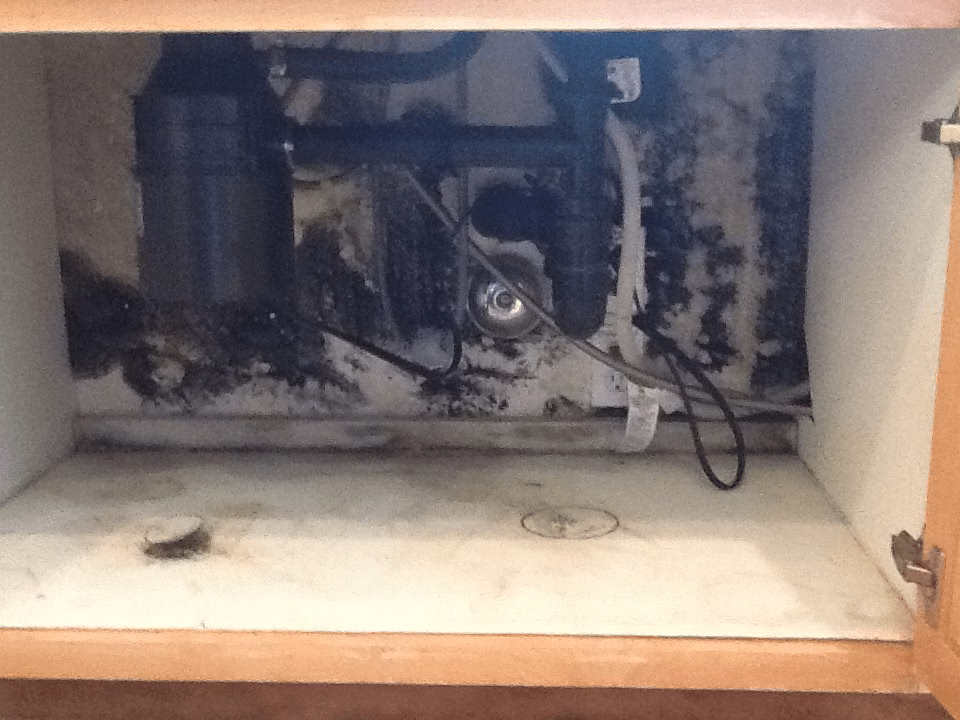Discovering mold in your kitchen cabinets can be alarming. Kitchen mold thrives in damp, poorly ventilated areas, often appearing inside cabinets due to plumbing leaks, humidity, or trapped moisture. If left untreated, mold can damage cabinetry, contaminate food, and even impact your health.
In this guide, we’ll cover how to clean mold in kitchen cabinets safely, when to call a professional, and how to prevent future mold growth.
What Causes Mold in Kitchen Cabinets?
Mold needs moisture, warmth, and organic materials to grow. Here’s what typically causes it in kitchen cabinets:
- Plumbing leaks – Leaky pipes under the sink create ideal mold conditions.
- Poor ventilation – Steam from cooking can raise humidity levels, leading to mold growth.
- Spills & food residue – Leftover crumbs or food spills encourage mold development.
- Condensation buildup – Cold cabinets in a warm kitchen cause condensation, creating a damp environment for mold.
- Old wood or porous surfaces – Mold easily embeds itself into wood, especially in older cabinets.
Step-by-Step Guide: How to Clean Mold in Kitchen Cabinets
Before you start: Wear protective gloves, a mask, and safety goggles to avoid inhaling mold spores.
Step 1: Identify the Extent of the Mold
- Check all cabinet corners, shelves, and under the sink for visible mold.
- Look for discoloration, musty odors, or peeling wood.
- If the mold covers more than 10 square feet, call a professional mold remediation expert like Advanced Restoration & Construction in Los Angeles.
Step 2: Remove Everything from the Cabinets
- Take out dishes, food, and utensils.
- Inspect items for mold contamination—discard anything moldy.
- Wash salvageable items in hot, soapy water with vinegar.
Step 3: Prepare a Natural Mold Cleaner
For small mold spots, use a DIY mold cleaner:
- White vinegar – Kills 80% of mold species naturally.
- Hydrogen peroxide (3%) – Disinfects surfaces and prevents regrowth.
- Baking soda – Absorbs moisture and eliminates odors.
- Dish soap & warm water – Removes surface mold.
Step 4: Scrub Mold Off the Cabinets
- Dip a scrub brush or sponge into the cleaning solution.
- Scrub affected areas in circular motions to lift mold spores.
- Wipe clean with a dry cloth.
Step 5: Disinfect the Cabinets
- Spray the area with undiluted white vinegar or hydrogen peroxide.
- Let it sit for 10–15 minutes before wiping it dry.
- Keep cabinet doors open for ventilation.
Step 6: Dry and Deodorize the Cabinets
- Use a dehumidifier or fan to dry the area completely.
- Sprinkle baking soda inside cabinets overnight to absorb moisture and odors.
- Place open charcoal bags or silica gel packets inside cabinets to prevent future moisture buildup.
Why DIY Mold Removal Isn’t Always Safe
While small mold patches can be cleaned at home, large mold infestations require professional removal. Here’s why:
✔ Hidden Mold Growth – Mold spreads behind walls and under cabinets, making complete removal difficult.
✔ Health Risks – Exposure to mold spores can trigger allergies, asthma, and respiratory issues.
✔ Structural Damage – Mold weakens wood, causing long-term damage to cabinetry.
✔ Recurring Mold – Without proper treatment, mold can return quickly.
If mold keeps coming back, contact Advanced Restoration & Construction for professional mold remediation in Los Angeles.
How to Prevent Mold in Kitchen Cabinets
Follow these tips to keep your cabinets mold-free:
✔ Fix Leaks Immediately – Repair any leaking pipes under the sink.
✔ Improve Ventilation – Use exhaust fans while cooking.
✔ Keep Cabinets Dry – Wipe down wet surfaces and store only dry items.
✔ Use Mold-Resistant Paint – Seal cabinets with antifungal paint.
✔ Store Food Properly – Avoid keeping perishables in humid cabinets.
✔ Regularly Clean Cabinets – Wipe down surfaces with vinegar or mild disinfectants.
When to Call Professional Mold Remediation Experts
If you notice persistent mold, a musty odor, or health symptoms, it’s time for professional help. Advanced Restoration & Construction offers:
- Thorough mold inspection – Identifying hidden mold growth.
- Advanced mold removal techniques – Safe and effective remediation.
- Moisture control solutions – Preventing future mold outbreaks.
- Cabinet repair and restoration – Fixing mold-damaged wood.
Don’t let mold damage your home! Contact Advanced Restoration & Construction in Los Angeles for expert mold removal today.
Faqs
Bleach only removes surface mold and doesn’t penetrate porous materials like wood. Vinegar or hydrogen peroxide is a safer alternative.
Black, green, or fuzzy mold with a strong musty odor may indicate toxic mold. It’s best to call professionals for an inspection.
Wipe down cabinets once a month with vinegar or a mild disinfectant to prevent moisture buildup.
Recurrent mold is a sign of hidden moisture issues. Call Advanced Restoration & Construction for a professional assessment.
Yes. Mold exposure can cause respiratory problems, allergies, and skin irritation. Prompt removal is essential.

